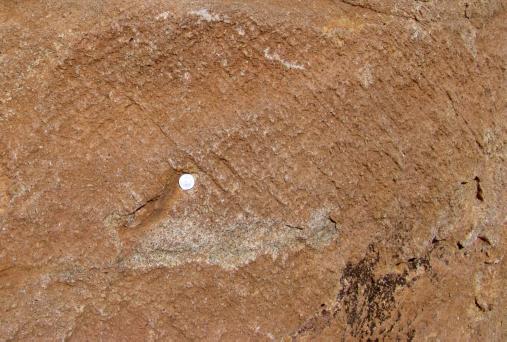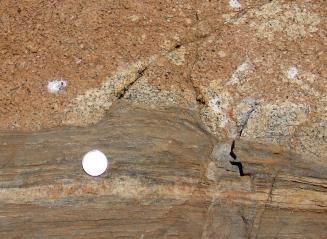| The Teixeira Pluton is cut by NE-trending sinistral shear zones and E-W trending dextral shear zones, typical of the large scale pattern of the Transversal Zone of the Borborema Province. These shear zones in the Teixeira Pluton can be inferred from lineament patterns on satelite images and produce deep valleys and controls the northern boundary of the pluton. In this page we document field relationships at an outcrop close to the northern margin of the pluton at Tendo, along the road from Patos to Teixeira (24M 0692226E 9203522N). There are three important aspects of the shear zones revealed here: a) overprinting relationships between the NE-trending sinistral and E-W trending dextral shear zones; b) most beautifully illustrated here, the ability of ultramylonites to effectively cross-cut the surrounding rocks; and c) the contemporaneous block movement of the country rock and internal folding of ultramylonites. |
a) Overprinting shear zones
|
The photographs
depict the overprinting of different shear zone orientation. Partly
there are sinistral shear zones of different NE-trending orientations,
cross-cutting one another, partly there are sinistral and dextral shear
zones cross-cutting and overprinting each other. |
| Figure 1a: Overprinting sinistral shear zones, rotated from their main NE-trend to N70E. | Figure 1b. Zooming in on a. | Figure 1c. Further zoom. |
b-c) Ultramylonites cross-cutting country rock, and contemporaneous folding and block movement
|
>The following
photographs
depict the ability of mylonites/ultramylonites, once formed, to behave
as a different rock type and in a different manner when compared to the
undeformed or weakly deformed protolith (granite). Here, not only is
shearing localized, but also the mylonite effectively truncates
structures in the surrounding rocks. The structures also record the shear folding of the ultramylonite to fill up the space created by rotation of blocks in the country rock. |

